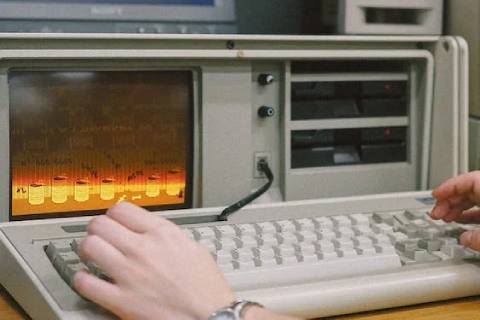The Evolution of Office Technology: Past, Present and Future
Technology has been transforming the way we work for a long time. From manual typewriters to advanced computers, we’ve come a long way in terms of office equipment. In this article, we’ll explore the evolution of office technology, discussing its impact on productivity, sustainability and the future of work.

Office technology has been evolving in leaps and bounds over the years, with each step bringing new capabilities and opportunities for businesses to improve their operations. From manual typewriters to advanced computers, the past has witnessed some significant changes in office equipment. The present continues to witness the rise of more sophisticated machines and the future promises much more. Let’s delve into the history of office technology, starting with the early days of typewriters and calculators.
The Early Days: Typewriters and Calculators
Before the advent of computers, the typewriter and calculator were the go-to office machines. Typewriters were invented in the 1870s and were widely used until the 1980s when computers took over. They allowed for the creation of neat and uniform documents, replacing handwritten documents that were often illegible or inconsistent.
Calculators, on the other hand, were first introduced in the early 1900s and provided a faster and more accurate way of performing arithmetic calculations. They were used extensively in accounting departments and helped reduce errors and save time.
The Impact of Typewriters and Calculators
Typewriters and calculators transformed the way people worked in offices during their time. They increased productivity and made work more efficient. Typewriters allowed for the creation of multiple copies of a document, making it easier to disseminate information to different departments. They also allowed for the creation of forms and templates, reducing the need for handwritten documents. Calculators, on the other hand, saved time by performing mathematical calculations accurately and quickly.
"The typewriter and calculator were the mainstays of the office for almost a century and revolutionized the way people worked. They allowed for faster and more accurate work, paving the way for future office technology."
Typewriters and calculators paved the way for future office technology, opening up new possibilities for automation and digitalization. They were an essential part of the office landscape for many years, providing a foundation for the technological advancements that were to come.
The Rise of Computers: Revolutionizing the Office

Computers revolutionized the way tasks were performed in offices. The introduction of office automation led to a shift from analog to digital technology, increasing productivity and efficiency.
As computers became more powerful, routine tasks such as data entry, record keeping, and accounting were replaced by software applications. This enabled employees to focus on more complex tasks that required human intelligence and creativity.
Office Automation
Office automation refers to the use of computers and software applications to automate routine tasks. This includes word processing, spreadsheets, databases, and email. These applications streamlined processes and allowed employees to accomplish more in less time.
Automation also improved the accuracy and consistency of tasks. For example, software applications eliminated the need for manual calculations in accounting, reducing the risk of human error.
Digital Technology
Digital technology replaced analog devices such as typewriters, calculators, and fax machines. This eliminated the need for paper-based documents and improved communication between employees.
The rise of digital technology also enabled employees to work remotely. Email and video conferencing made it possible for employees to collaborate with colleagues and clients from anywhere in the world.
The Future of Computers in Offices
The future of office computers is about artificial intelligence and automation. These emerging technologies have the potential to further streamline processes and improve efficiency.
Artificial intelligence can be used to automate routine tasks such as data entry, scheduling, and customer service. This frees up time for employees to focus on tasks that require human intelligence and creativity.
Automation can also improve the accuracy and consistency of tasks. For example, chatbots can be used to provide customer support, reducing the need for human operators. This also improves response times and customer satisfaction.
In conclusion, the rise of computers in offices revolutionized the way tasks were performed. Automation and digital technology streamlined processes and increased productivity and efficiency. The future of office technology is about artificial intelligence and automation, which have the potential to further improve processes and reduce the need for human intervention.
The Modern Office: Connectivity and Mobility

In today's fast-paced work environment, employees need to stay connected and productive, even when they are away from the office. Advances in technology have enabled the modern workforce to work from anywhere, at any time.
The rise of laptops, smartphones, and cloud computing has made it possible for employees to access work files and collaborate with colleagues from virtually anywhere in the world. This level of connectivity and mobility has transformed the way we work, making us more efficient and productive.
But with this newfound freedom comes challenges. Companies need to ensure their data is secure and protected when accessed from multiple devices and locations outside of the office.
Despite these challenges, the benefits of a modern, connected office environment are clear. Employees can work on the go, from home, or while traveling, without sacrificing productivity. Companies can also save on office space and overhead costs by allowing employees to work remotely.
The future of the modern office will undoubtedly bring even more advances in connectivity and mobility, making it easier than ever to stay connected and productive from anywhere in the world.
The Future of Office Technology: Artificial Intelligence and Automation

As technology continues to advance, we can expect significant changes in the way we work. One area that is likely to see a major transformation is the role of artificial intelligence (AI) and automation in the office.
AI has the potential to enhance productivity and efficiency by automating repetitive tasks and providing valuable insights into data. For example, AI-powered virtual assistants can help schedule meetings and manage emails, freeing up time for more important work.
Another area where AI and automation can have a significant impact is in document processing. AI-powered software can analyze and extract data from documents, reducing the time and effort required for manual data entry.
However, there are also concerns about the impact of AI and automation on jobs. As machines become more capable of performing tasks traditionally done by humans, there is a risk of job displacement. It is important for companies to carefully consider the ethical implications of these technologies and ensure a smooth transition for employees.
Despite these challenges, the potential benefits of AI and automation in the office are significant. By streamlining processes and enhancing productivity, these technologies can help companies stay competitive in a rapidly changing business landscape.
The Impact of Office Technology on Productivity and Efficiency
Advancements in office technology have had a tremendous impact on productivity and efficiency in the workplace. With the introduction of computers and digital technology, tasks that once took hours to complete can now be done in minutes.
One significant improvement is in communication. Email, instant messaging, and video conferencing have made it possible for employees to communicate more quickly and efficiently, regardless of their location. This has led to smoother teamwork, better collaboration, and faster decision-making.
Another benefit of office technology is automation. Repetitive tasks such as data entry and file organization can now be done automatically, freeing up time for more important projects. Additionally, software programs such as project management tools and CRM systems have streamlined workflows, reducing the time and effort required to complete tasks.
Furthermore, office technology has made it possible for employees to work from anywhere. With the rise of laptops, smartphones, and cloud computing, employees no longer need to be tethered to their desks. This has led to increased flexibility, better work-life balance, and higher job satisfaction.
Overall, office technology has revolutionized the way we work and has significantly increased productivity and efficiency in the workplace. As technology continues to evolve, it is certain to bring even more improvements and benefits in the future.
The Role of Office Technology in Sustainability
Office technology has come a long way, not just in terms of productivity and efficiency, but also in sustainability. With the growing concern for the environment, businesses are increasingly turning to eco-friendly practices, and technology has played a significant role in this effort.
The Advancement of Eco-Friendly Office Equipment
One of the most significant ways that office technology has contributed to sustainability is through the development of eco-friendly office equipment. Manufacturers are now producing energy-efficient printers, copiers, and scanners that consume less power and reduce waste. Furthermore, some office equipment can automatically adjust power settings when not in use, reducing energy consumption and carbon footprint.
Another example of eco-friendly office equipment is the use of recycled materials. Many manufacturers are starting to incorporate recycled plastic and other materials into their products, reducing waste and carbon emissions.
|
Benefits of Eco-Friendly Office Equipment: |
Challenges of Eco-Friendly Office Equipment: |
|
|
The Role of Technology in Reducing Paper Waste

Another way that technology has contributed to sustainability in the office is through the reduction of paper waste. With the widespread adoption of digital technology, many businesses are now able to operate in a paperless environment, greatly reducing paper consumption and waste.
Electronic documents and cloud storage have made it possible for businesses to store and share documents electronically, reducing the need for physical copies. Furthermore, the use of electronic signatures has made it possible for businesses to sign documents digitally, eliminating the need for paper-based signatures.
The Impact of Technology on Energy Consumption
Technology has also played a significant role in reducing energy consumption in the office. Many businesses are now adopting energy-efficient practices, such as turning off electronics when not in use and utilizing natural lighting sources. Furthermore, the use of smart technology has made it possible for businesses to monitor and control energy consumption, reducing waste and costs.
"Technology has played an integral role in reducing the environmental footprint of businesses. By adopting eco-friendly practices in the workplace, businesses can reduce waste, conserve energy, and promote sustainability."
Technology has played an integral role in reducing the environmental footprint of businesses. By adopting eco-friendly practices in the workplace, businesses can reduce waste, conserve energy, and promote sustainability. With the continuous advancement of technology, it's exciting to see the potential for further contributions to sustainability in the future.
The Role of Office Technology in Sustainability
As businesses become more environmentally conscious, the role of office technology in sustainability has become increasingly important. Here are some frequently asked questions about how office technology can contribute to sustainability efforts:
How can technology help reduce paper waste in the office?
One of the most significant ways technology can contribute to sustainability is by reducing paper waste. By implementing digital solutions such as electronic document management systems, employees can easily store, organize, and share documents without the need for printed copies. Additionally, cloud-based software and collaboration tools allow teams to work on documents simultaneously, reducing the need for multiple paper copies.
Is office equipment energy efficient?
Many modern office machines are designed with energy efficiency in mind. Look for devices with Energy Star certification, which indicates that the equipment is designed to use less energy than comparable models. Additionally, implementing power-saving settings on devices when not in use can significantly reduce energy consumption in the office.
Can recycling programs be implemented for old office hardware?
Recycling old office hardware is an essential part of sustainability efforts. Look for recycling programs or partnering with e-waste disposal services that can help responsibly dispose of old hardware. It's important to ensure that any sensitive data is removed before recycling or disposal.
What are some eco-friendly office supplies?
There are many eco-friendly office supplies available, such as recycled paper, refillable ink cartridges, and biodegradable pens. Additionally, implementing a "bring-your-own-mug" policy can reduce the need for disposable cups and cutlery in the office.
Are there any downsides to going paperless in the office?
While going paperless can offer significant environmental benefits and increase efficiency, there are some potential downsides. One is the need for digital security measures to protect sensitive information stored electronically. Additionally, not all employees may be comfortable with digital tools, and training may be required to ensure effective adoption.
By leveraging technology in a sustainable way, businesses can reduce their environmental impact and contribute to a more environmentally conscious future.

